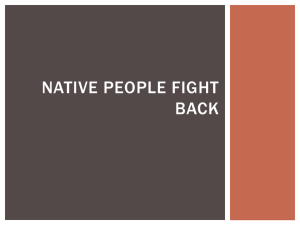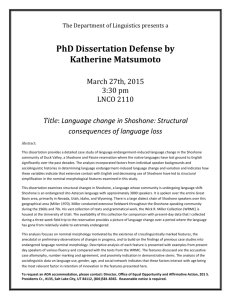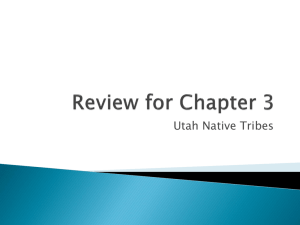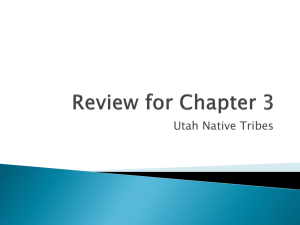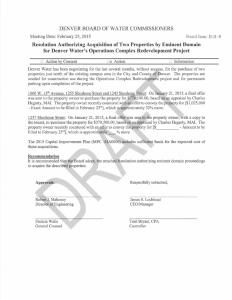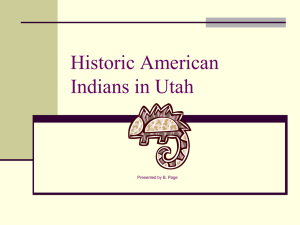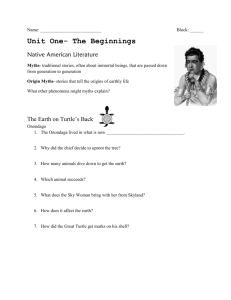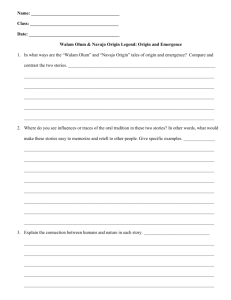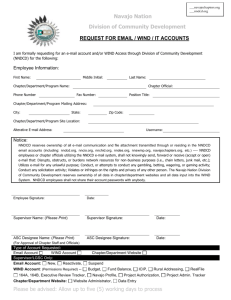Historic American Indians in Utah
advertisement
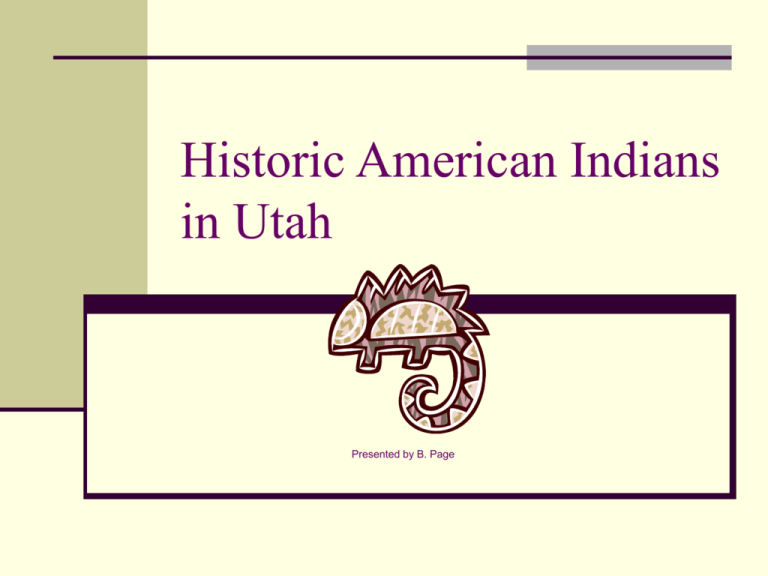
Historic American Indians in Utah Presented by B. Page Pre-Historic Vs. Historic Pre-Historic peoples have no written history Historic peoples do have a written history Native History Native Americans have lived in and around Utah for thousands of years. Their way of life changed dramatically when other groups of people entered Utah. These groups included: Spanish explorers Catholic priests Fur trappers Pioneers Native History Continued These people wrote about the American Indians they met in their journals and diaries. Do you think these written accounts by explorers or pioneers accurately represent how the Indian people lived and how they felt about things? ? Who Are They? Ute Shoshone Goshute Paiute Navajo Relationships Between Tribes “Tribal boundaries were important and were usually respected. If a person from an enemy band or tribe came onto their land, the intruder might be taken prisoner or killed. Some tribes were more friendly to newcomers than other tribes, depending on the time and the situation.” –Utah: A Journey of Discovery p. 53. The Utes The word “Utah” comes from the Ute word for “top of the mountains.” The Utes were the largest tribe in Utah. Their tribal area covered most of the central part of the state. The Utes lived in fertile valleys near the mountains and lakes. The Utes: Survival “Nuche [Utes] traveled with the seasons. They went to high mountains in the summer, living by hunting small and big game animals and birds, fishing and gathering a variety of berries, nuts, seed, and plants . . . Hunting, fishing, and gathering sites were not owned . . . [they were] communal [shared] and granted to all.” --Larry Cesspooch, a Ute The Utes: Hunting The Utes used horses for hunting and carrying heavy loads. When they hunted buffalo, they used every part of the animal. Some uses are: Fur for blankets Skin for tepees and clothing Meat for food The Utes: Home Life Utes lived in tepees of buffalo skin and tall poles. Tepees could be taken down and carried easily. A fire was built in the center for cooking and warmth. Smoke escaped through an opening in the top of the tepee. Bands of as many as 200 people lived in large tepee villages near streams, rivers, or lakes. The Utes: Families Finding and preparing food was the most important task of all members of a Ute family. When young women reached adulthood, they would participate in a Bear Dance where they would find their future husbands. The Utes: Children In addition to a formal name, a Ute child was given many nicknames during their life. Children were highly valued and everyone shared the responsibility of raising them. If twins were born, it was considered bad luck. Often, one or both twins were allowed to die. The Utes: Clothing Clothing was often made of animal skins. Sometimes the fur was still attached. Other clothing was made from woven grasses and bark. To protect their feet, the Utes wore shoes from animal hides or sandals of woven reeds. The Utes: Religion The Utes believed that the earth was created by a spirit who lived in the sky. They also believed that every living in the world had a spirit. The Ghost Dance represented the return of all who had died as a result of contact with non-Indians. Pictured here is a typical Ghost Dance dress. The Shoshone The Shoshone lived in the mountains and valleys of northern Utah. The name “Shoshone” means “valley dwellers.” Today, many Shoshone live on the Fort Hall Reservation in southeastern Idaho, which they share with the Bannock tribe. Perhaps the most famous Shoshone was Sacagawea, the woman who led Lewis and Clark through the west. The Shoshone: Survival In the mountains and valleys where the Shoshone lived, food was all around them. However, they had to follow the animals, so they were called “nomads.” Like the Ute clans, the Shoshone hunted animals such as buffalo, deer, and antelope and gathered nuts and berries for food. They also raised horses for hunting and moving around. The Shoshone: Home Life The Shoshone also constructed tepees from animal hide and poles. This picture shows a tepee that has been painted, perhaps with a clan or family symbol. Some other Shoshone bands dug shelters out of hillsides. The Shoshone: Families Men and women had equally important roles. The men hunted and served as chiefs, or leaders, of the bands. Women raised children and gathered plants. Like other Native Americans, the Shoshone did not spank or punish their children. The Shoshone: Children Children did not have formal schooling. They learned by working alongside adults and by listening to songs and stories. Many children would made balls of hide and rabbit hair or dolls to play with. The Shoshone: Clothing The Shoshone’s clothing was almost identical to the Ute’s. Animal skins and woven grasses made most of their clothing. In the winter, women would often wear a special robe made of about forty woven rabbit skins. The Shoshone: Clothing Continued Beadwork was also an important part of Shoshone clothing and ceremonial items. Pictured here are beaded moccasins and a ceremonial peace pipe with beaded bag. The Shoshone: Religion The Shoshone believed in one being called Duma Appáh, Our Father, or the Creator. Each morning the Shoshone faced the sun in the east and sang a prayer to Appáh. Appáh was said to have created Earth with the help of the animal creatures, especially Coyote. The Goshutes The Goshutes lived in the central Great Basin area of Utah. The Goshutes: Survival The Goshutes lived in a very dry land with little rain. They were able to find uses for more than 100 desert plants. The Goshutes were hunter/gatherers. They also ate roasted crickets. The Goshute often dug for roots. For this reason, white men often called them “root diggers.” The Goshutes: Home Life The Goshutes lived in wiki-ups, small brush covered shelters, during the warmer months. However, in the winter, they would often move to caves or more sturdy shelter. The Goshutes: Families The Goshutes hunted together in family groups and would often cooperate with other family groups that usually made up a village. Men usually did the hunting, while women gathered plants and seeds. The Goshutes: Children Goshute children helped their mothers gather plants, seeds, and insects. The Goshutes: Clothing In the winter months, rabbit skin blankets were used for warmth. Because the Goshute lived in the desert, they did not need much clothing during the summer months. Men wore breechcloths Women wore aprons or grass skirts Twig sunshades often worn on heads The Goshutes: Religion Like all Indian tribes, the Goshute held a great respect for the earth, the spirits, and their fellow living beings. The Paiutes The Paiutes lived in the southwest corner of Utah. The Paiutes: Survival Like the Goshutes, the Paiutes lived in a very dry region with little rain. Like all Utah Indian tribes, the Paiute were also hunter/gatherers. Some Paiutes irrigated some crops including corn, beans, squash, and wheat. The Paiutes: Home Life The Paiutes also lived in brush wiki-ups in the summer and caves during the winter. They lived in large family groups found in small villages. The Paiutes: Families Small family groups would travel separately collecting seeds, berries, roots, and hunting small animals, deer, mountain sheep, elk, and fish. These groups met and intermarried with other Paiutes, as well as other Indian tribes. The Paiutes: Children Children helped their parents gather food goods to be stored for the winter. Children learned from their parents and grandparents about animals, plants, and storytelling. The Paiutes: Clothing Similar to the Goshute people, the Paiutes had very little use for clothing in warm weather. Often during the summer, Paiute children would wear no clothes at all. During the colder winter months, everyone wore shirts and used blankets made of rabbit skin. The Paiutes: Religion A Paiute man named Wovoka introduced the Ghost Dance, a religious movement that spread throughout the nation. The Ghost dance represented the return of all Indians who had died as a result of contact with nonIndians. Ghost Dance Continued The Navajo The Navajo called themselves the Dinè, or “the people.” The Navajo lived in the southeastern corner of Utah, below the San Juan River. Many Navajo today live on a reservation in that same area. The Navajo: Survival The Navajo used horses for hunting and carrying heavy loads. They also raised sheep and goats. Some clans closer to the San Juan River practiced irrigation and farming. The Navajo: Home Life The Navajo lived in hogans. They considered their homes to be a symbol of spiritual connection to Mother Earth. Hogan doors always face east to meet the morning sun. Hogans were placed far apart; there were no villages. The Navajo: Families The most important person in a Navajo family is the mother. Women own the house, the sheep, the goats, and any wages earned from weaving. Men own the horses, the wages earned from their jobs, and any items or money they brought into the marriage. Navajo men and their mothers-in-law are not allowed to talk to-or even look at-each other. This custom probably reduces the number of family arguments! The Navajo: Children Children play an important role in a Navajo family. Even when they are very young, Navajo children care for some of the family’s sheep or help with grown-up chores. Each Navajo child is given a secret “war” name by the parents, used only for special religious ceremonies. The Navajo: Clothing The Navajos sheered wool from their sheep and made it into yarn. The yarn was then dyed from plants to make colors. The dyed yarn was woven into rugs, blankets, and cloth. The Navajo: Religion Navajo religion is sometimes called “The Way.” It is a code of behavior for everyday life, not just weekly worship. Ceremonies are called “ways.” One of the most important ceremonies is called the “Nightway.” Nightways are nine day healing ceremonies. Sand paintings are made as part of the Nightway. Navajo Sand Paintings Native Languages American Indian groups spoke many different languages. When trappers and explorers met them, none of the tribes had written alphabets. Many Indian languages have become extinct because they were not written down or passed on. Native Language Continued Each tribe had legends and myths that were passed down through an oral tradition of storytelling. Many myths were about animals Others were called creation myths End of an Era The coming of white men forever changed the life of American Indians in Utah. The new people brought new tools and ideas, as well as new diseases. The Indians and settlers worked to get along, although they did not always succeed. Today, American Indians, like this Ute Medicine Man, strive to keep the traditions of their past alive.
